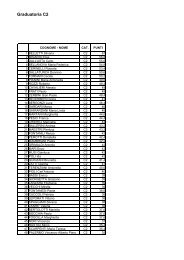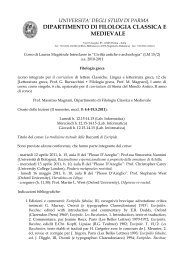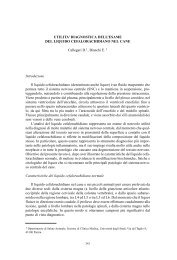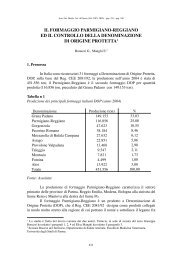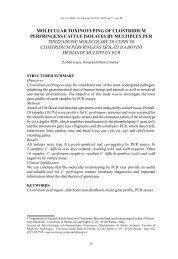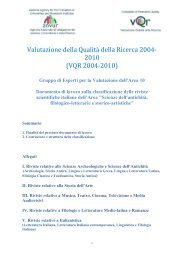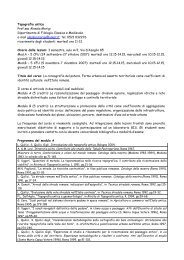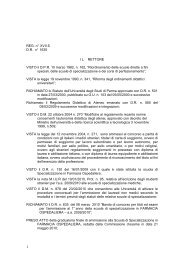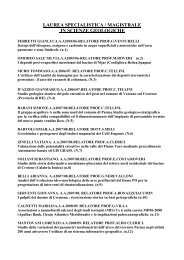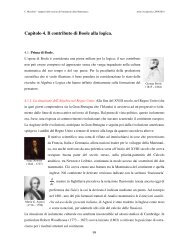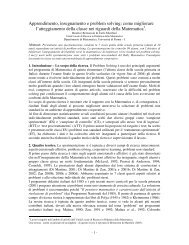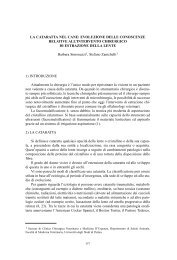Ann. Fac. Medic. Vet. di Parma (Vol. XXVII, 2007) pag. 143 - pag. 156saggi ELISA e/o la ricerca delle relative sequenze geniche mediante reazioni diamplificazione genica, dovranno essere eseguite sui ceppi di C. perfr<strong>in</strong>gens e diC. difficile per poter valutare correttamente le implicazioni e il significatoepidemiologico di questi ritrovamenti nei campioni di feci di cani diarroici e non.AbstractThe purpose <strong>of</strong> this epidemiological study was to evaluate the prevalence<strong>of</strong> <strong>Clostridium</strong> spp. among <strong>diarrhoeic</strong> <strong>and</strong> <strong>healthy</strong> <strong>dogs</strong>. Particular attention wasaddressed to C. perfr<strong>in</strong>gens <strong>and</strong> C. difficile isolation, s<strong>in</strong>ce these microrganisms havebeen associated with acute <strong>and</strong> chronic large <strong>and</strong> small bowel diarrhoea, <strong>and</strong> acutehemorrhagic diarrhoeal syndrome <strong>in</strong> the dog.Some <strong>dogs</strong> were kennelled <strong>dogs</strong>, others belonged to students <strong>and</strong> staff <strong>of</strong>the Veter<strong>in</strong>ary Faculty <strong>of</strong> Parma, <strong>and</strong> others were <strong>dogs</strong> admitted to the DidacticVeter<strong>in</strong>ary Hospital.A total <strong>of</strong> 95 can<strong>in</strong>e fecal samples (36 <strong>diarrhoeic</strong> <strong>and</strong> 59 non-<strong>diarrhoeic</strong> <strong>dogs</strong>),collected from July 2006 to March 2007, were analysed by culture assay. Sixty-two <strong>of</strong>the 95 fecal specimens (65.3%) were positive for one or more <strong>Clostridium</strong> spp. A total<strong>of</strong> 89 different <strong>Clostridium</strong> stra<strong>in</strong>s were identified. The most common <strong>Clostridium</strong>detected was C. perfr<strong>in</strong>gens (15.7%), followed by C. bifermentans (13.5%),C. clostridiiforme (13.5%), C. fallax (12.4%), C. beijer<strong>in</strong>ckii/butyricum (11.2%),C. difficile (11.2%), <strong>and</strong> C. septicum (9.0%). Other <strong>Clostridium</strong> species were isolated<strong>in</strong> lower percentage, rang<strong>in</strong>g from 2.3% to 1.0%.Relatively to C. perfr<strong>in</strong>gens isolation, 6 <strong>of</strong> the 14 positive fecal samples(42.9%) belonged to <strong>diarrhoeic</strong> <strong>dogs</strong>. In the case <strong>of</strong> C. difficile, the 80.0% (8 <strong>of</strong> 10) <strong>of</strong>can<strong>in</strong>e fecal samples positive by culture assay belonged to <strong>dogs</strong> with enteritis.Further <strong>in</strong>vestigations (concern<strong>in</strong>g, for example, the detection <strong>of</strong> tox<strong>in</strong>production by ELISA assays <strong>and</strong>/or the gene revelation by polymerase cha<strong>in</strong> reactions)should be applied on C. perfr<strong>in</strong>gens <strong>and</strong> C. difficile stra<strong>in</strong>s to assess properly the fullimplications <strong>and</strong> the epidemiological mean<strong>in</strong>g <strong>of</strong> these f<strong>in</strong>d<strong>in</strong>gs <strong>in</strong> fecal samples <strong>of</strong><strong>diarrhoeic</strong> <strong>and</strong> non-<strong>diarrhoeic</strong> <strong>dogs</strong>.IntroductionThe development <strong>of</strong> microbiota <strong>of</strong> <strong>dogs</strong> beg<strong>in</strong>s at birth when the sterile foetusis colonized <strong>in</strong> the birth canal <strong>and</strong> by the immediate environment. The succession <strong>of</strong>events <strong>in</strong> bacterial colonization is similar <strong>in</strong> the human <strong>and</strong> can<strong>in</strong>e <strong>in</strong>test<strong>in</strong>e, with thevery first colonizers orig<strong>in</strong>at<strong>in</strong>g from the mother, followed by microbes benefit<strong>in</strong>gfrom breast-feeed<strong>in</strong>g <strong>and</strong> then drastically chang<strong>in</strong>g towards obligate anaerobes <strong>and</strong>heterogeneous flora as solid foods are <strong>in</strong>troduced [10].The gastro<strong>in</strong>test<strong>in</strong>al tract <strong>of</strong> <strong>dogs</strong> is colonized by a variety <strong>of</strong> microrganisms.The number <strong>of</strong> microrganisms <strong>in</strong>creases from approximately 10 2 -10 5 colony form<strong>in</strong>gunits (CFU)/g <strong>in</strong> the proximal small <strong>in</strong>test<strong>in</strong>e to 10 5 -10 9 CFU/g <strong>in</strong> the distal small<strong>in</strong>test<strong>in</strong>e, <strong>and</strong> then dramatically rises <strong>in</strong> the large <strong>in</strong>test<strong>in</strong>e to approximately 10 10 -10 11 <strong>in</strong> the colon [1]. This quantitative proximal-distal gradient is accompanied144
Ann. Fac. Medic. Vet. di Parma (Vol. XXVII, 2007) pag. 143 - pag. 156by complex qualitative changes from a predom<strong>in</strong>antly aerobic flora <strong>in</strong> the small<strong>in</strong>test<strong>in</strong>e to a predom<strong>in</strong>antly anaerobic flora <strong>in</strong> the large <strong>in</strong>test<strong>in</strong>e. There is a widevariation <strong>in</strong> the bacterial flora between normal <strong>in</strong>dividuals, <strong>and</strong> concentrations maybe affected by a variety <strong>of</strong> circumstances or behaviours, <strong>in</strong>clud<strong>in</strong>g environment, diet,scaveng<strong>in</strong>g <strong>and</strong> coprophagia. Increased numbers <strong>of</strong> bacteria <strong>in</strong> the small <strong>in</strong>test<strong>in</strong>ecarry an <strong>in</strong>creased risk <strong>of</strong> a harmful outcome. Whether this is manifest cl<strong>in</strong>ically willdepend on <strong>in</strong>dividual circumstances, <strong>in</strong>clud<strong>in</strong>g the composition <strong>of</strong> the diet whichbacteria can convert to potentially harmful metabolites. The nature <strong>of</strong> a host responseto the <strong>in</strong>creased load could also be important, <strong>and</strong> this may <strong>in</strong>volve stimulation <strong>of</strong>immunoglobul<strong>in</strong> <strong>and</strong> mucus production, suppression <strong>of</strong> potentially damag<strong>in</strong>g cellmediated immune responses, a compensatory production <strong>of</strong> structural <strong>and</strong> functionalepithelial cell prote<strong>in</strong>s, <strong>and</strong> <strong>in</strong>creased epithelial cell turnover. The threshold betweenapparent normality <strong>and</strong> cl<strong>in</strong>ical disease may therefore differ between <strong>in</strong>dividuals <strong>and</strong>be <strong>in</strong>fluenced by a delicate balance between the micr<strong>of</strong>lora <strong>and</strong> the host. Cl<strong>in</strong>icaldisease associated with bacterial overgrowth is a very common problem <strong>in</strong> <strong>dogs</strong> <strong>and</strong>occurs when this balance is tipped aga<strong>in</strong>st the host [1].Primary enteric bacterial pathogens can also cause acute cl<strong>in</strong>ical diseases<strong>in</strong>ce they possess virulence factors with adverse effect on the <strong>in</strong>test<strong>in</strong>e. Adherenceto the surface or <strong>in</strong>vasion <strong>of</strong> the mucosa facilitate long-term colonization by certa<strong>in</strong>enteropathogens, predispos<strong>in</strong>g to a carrier status or chronic disease, the outcomeprobably depend<strong>in</strong>g on expression <strong>of</strong> virulence determ<strong>in</strong>ants <strong>and</strong> the host response[1].S<strong>in</strong>ce <strong>dogs</strong> are carnivorous, the total length <strong>of</strong> their <strong>in</strong>test<strong>in</strong>e <strong>in</strong> relation to thebody length is somewhat shorter <strong>and</strong> the motility slower than <strong>in</strong> humans. As a wholethe digestive tract <strong>of</strong> dog, however, resembles that <strong>of</strong> humans <strong>and</strong> the physiologyis similar <strong>in</strong> many ways. Like humans, <strong>dogs</strong> utilize <strong>in</strong>test<strong>in</strong>al microbiota <strong>in</strong> theirphysiology <strong>and</strong> both are homothermic mammals. The pH values <strong>in</strong> the differentcompartments <strong>of</strong> the digestive tract are also comparable to those <strong>of</strong> human, be<strong>in</strong>g thepH <strong>in</strong> the dog stomach 3, <strong>in</strong> duodenum <strong>and</strong> jejunum 6, <strong>in</strong> ileum 7.5, <strong>in</strong> colon 6.5 <strong>and</strong><strong>in</strong> feces 6.2 [10].The ma<strong>in</strong> cultivable bacterial groups <strong>and</strong> most common f<strong>in</strong>d<strong>in</strong>gs <strong>in</strong> humans<strong>and</strong> <strong>dogs</strong> are similar, <strong>in</strong>clud<strong>in</strong>g clostridia, bacteroides, streptococci, coliforms,enterococci, lactobacilli <strong>and</strong> veillonellae with <strong>in</strong>creas<strong>in</strong>g counts towards the large<strong>in</strong>test<strong>in</strong>e [10]. Most <strong>in</strong>test<strong>in</strong>al pathogens cause similar cl<strong>in</strong>ical symptoms <strong>in</strong> <strong>dogs</strong> as<strong>in</strong> humans (C. difficile, multiresistant Gram-negatives, enterococci, staphylococci).The most common <strong>in</strong>test<strong>in</strong>al dysfunction <strong>in</strong> <strong>dogs</strong> is diarrhoea. Another commondisturbance, small <strong>in</strong>test<strong>in</strong>al bacterial overgrowth, compos<strong>in</strong>g <strong>of</strong> Escherichia coli,enterococci <strong>and</strong> clostridia is associated with raised serum folate, reduced serumvitam<strong>in</strong> B12 concentrations <strong>and</strong> altered mucosal permeability <strong>and</strong> function [10].In the most cases <strong>of</strong> bacterial overgrowth, the cause cannot be identified, buthost factors known to predispose to bacterial overgrowth <strong>in</strong>clude defective gastric acidsecretion, <strong>in</strong>terference with normal motility or stasis, <strong>and</strong> defective local immunity[1]. Other factors, as a potentially stressful or contam<strong>in</strong>ed environment, diet <strong>and</strong>coprophagia, may also play a role <strong>and</strong> could contribute to the relatively high numbers<strong>of</strong> bacteria reported <strong>in</strong> kennelled <strong>dogs</strong> [1]. The damag<strong>in</strong>g consequences <strong>of</strong> overgrowth145



